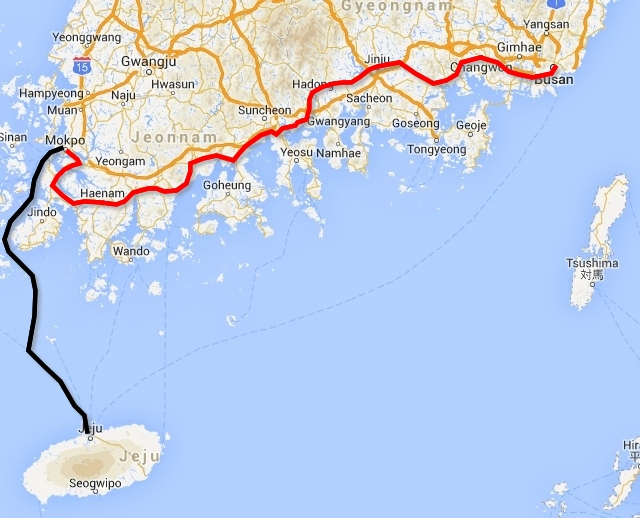
Nothing compares to the simple pleasure of a bike ride. J.F.Kennedy
Search this website
Southern Coastline
Mokpo, Gangjin, Jangheung, Suncheong, Gwangyang, Hadong, Jinju, Masan, Jinhae, Busan
Navigational Problems
I got up at 06:00, having slept for less than 5 hours and this was reflected in my mental abilities. I wanted to take the southern Road 2, so I set my request in the GPS and let my mind wander. I 'woke up' 10 km later, realizing that the GPS was taking me somewhere I did not want to go. I turned it off in a huff and followed my own directions, pleased with myself. Close to Road 2, there was a bike path with a reasonably good surface. Suddenly the bike path ended. Signs appeared on Road 2, forbidding bicycles and scooters. I searched for a parallel cycle path, until then there had always been one, but not that time. There was no option of cycling around it in any way, so I had to turn back. I could return to Mokpo, 50 km on a bike path along the river and then on local roads to Suncheon. I was not so keen on that, I do not like cycling on the same route. So on my way back, I welcomed a turn-off towards the south and Road 18. Although it was 50 km longer, it would be on a new route and I would get on to Road 2 finally as well.
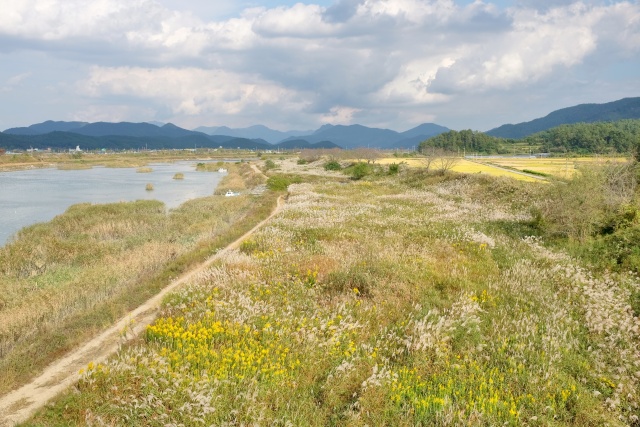
Gangjin: Scenery beside the river
I cycled via the Korean F1 ring road on a very good quality, not very busy road, from which I took the turn-off to the east on to a local minor road to Haenam. While savoring the Korean agricultural countryside and small villages, I also got hungry. The moment I saw the steam from steam-cookers appearing around the bend ahead of me, I did not hesitate for an instant. I ordered and ate one portion of mandu and took a second portion as a take-away for dinner or breakfast.
In Gangjin I connected to Road 2, which was no longer a motorway, but still very busy with two lanes in both directions, separated by a safety fence in the middle. Interestingly, electric cars were not allowed on it, a special sign was used for this. However, cyclists were permitted. I passed several police patrol cars who often even waved at me. At about 15:00 I started falling asleep while still on the bike; the legs were still pedaling, but my brain was numb. I had not slept enough, it was time to stop for the day.
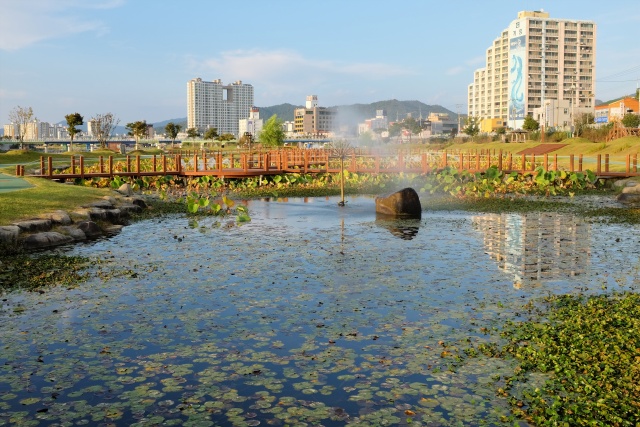
Jangheung: I slept in a quiet corner of this park with fountains
I arrived in the small town of Jangheung (16000 inhabitants) on the Tamjin River, where I would find somewhere to pitch my tent. I cycled along the river on a bike path and located two prime spots for hygienic purposes (public restrooms with running water). Satisfied, I cycled to a small local NG supermarket. I ate two fishcakes with about a liter of soup (unlimited amount for about 10 CZK – $0,5 – when buying the fishcake), and sundae plate (sausage reminiscent of Czech black pudding). I then purchased yoghurt, beer and the necessary plum wine, the only drink I liked there. There was a row of motels along the river, aggressively flashing colored neon signs. But I had already decided. I lay down my head in my tent at 20:00 and woke up 10 hours later at 06:00 the following morning.
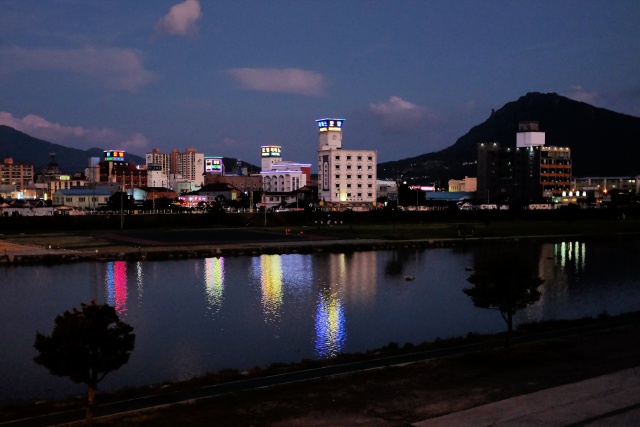
Jangheung: Hotels were invitingly beckoning me, but I had already found my bedroom in the park
The disadvantage of sleeping next to a river, and water in general, was the morning mist covering the tent in dense dew. My new and super-light tent had a flysheet which absorbed the water, but did not allow it to pass through. However, when I packed it all up, everything became damp.
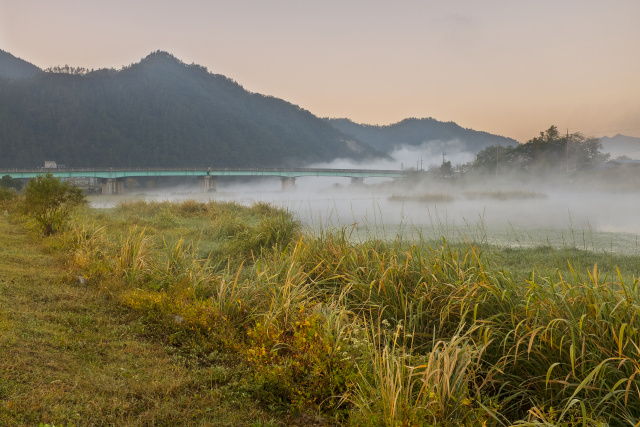
Jangheung: Morning fog
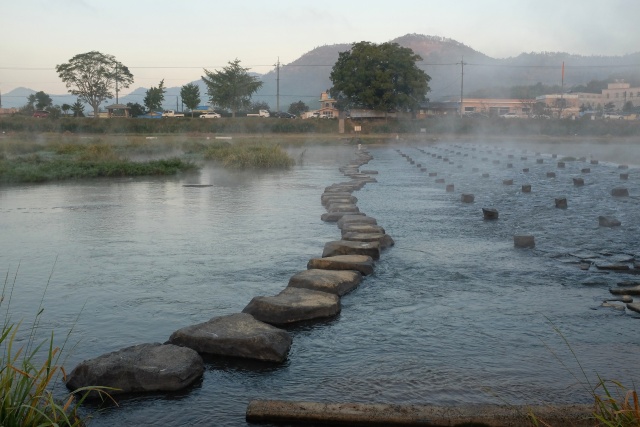
Jangheung: River crossing
Another Flat
The following morning the back tire was half flat. I pushed the bicycle for about 1 km to the restroom and started to repair it. I was puzzled by the fact that it was not completely flat and soon found out why. When opening the valve, the inner valve shot into my hand, it had been unscrewed. It was easy to repair, but just to be sure, I checked the inner tube in the sink too. While at it, I oiled the pedals and chain, calculating whether I had to change it, and checked that all the screws on the racks were tight.
I cycled to the nearest convenience store, this time it was called MiniStop, purchased an instant Sesam Ramen (noodle soup) and poured hot water over it. I also used the hot water to make a cup of tea and used their microwave to warm up the mandu from the previous day. I ate all of that on the table outside the store. It was a great breakfast "on the fly" or rather "on the chopsticks."
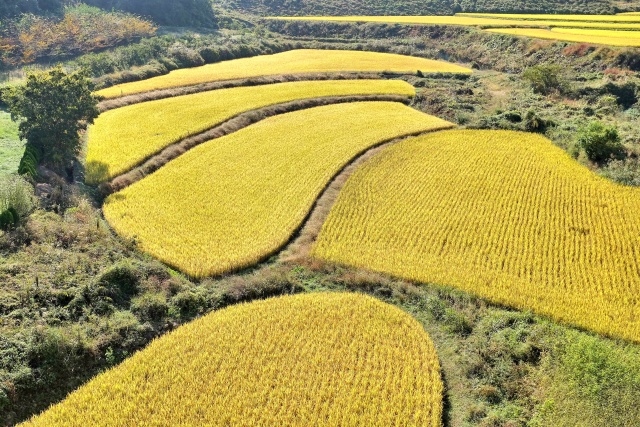
E of Jangheung: Rice field
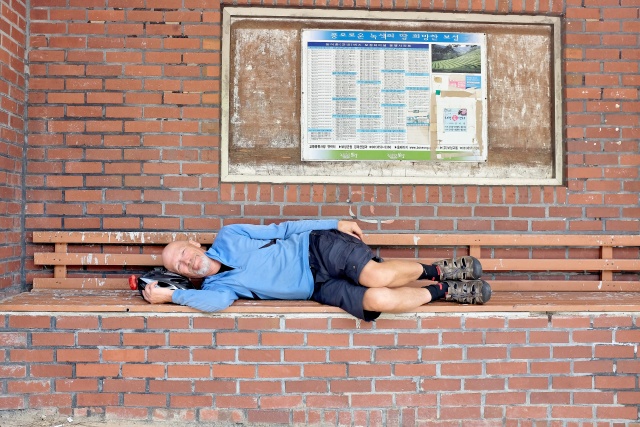
W of Beolgyo: Midday nap at the bus station; I had to digest a portion of mandu
Hilly countryside meant tunnels on the better roads. In 5 km there were already three tunnels. Not very long ones, the longest one was 835 m, the next one 380 m and then 570 m. The longest one was also the oldest and the worst. It was only lit for 20 meters and then the next 60 meters were totally dark. I had made a mistake, I only had my back light on, the front one was lying in the handlebar bag.
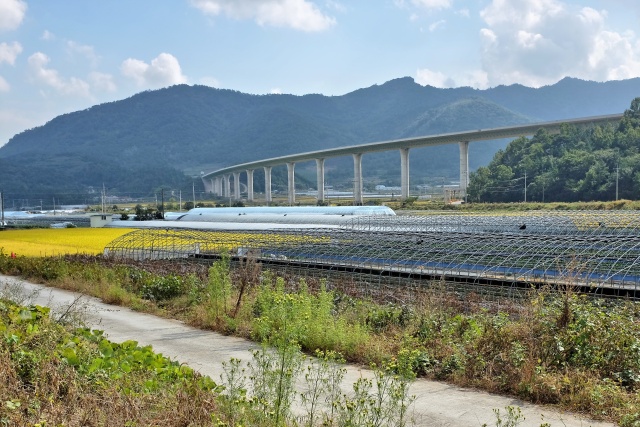
Near Guryong: Highway bridge
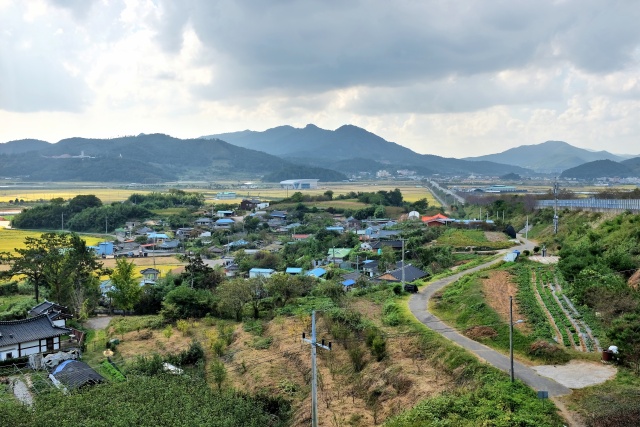
Near Suncheong: Village
I spent the whole day on Road 2 and towards evening arrived in Gwangyang city. I searched for accommodation, but it seemed as if I would not have any luck. In front of the City Hall was a small park, but no source of water. I cycled to the sea, but there was only a massive construction area and clutter from a new bridge construction. I tried following Road 2 for a few more kilometers and just when I was ready to return to the city and find a motel, I spotted an attractive lake with my favorite ablutions, so all was well. I cycled the 4 km back to the city, ate at the market and at dusk cycled back to the lake. I pitched my tent and let it dry out for about one hour before moving in. Still, I was not very successful, as it was quite damp at the lake.
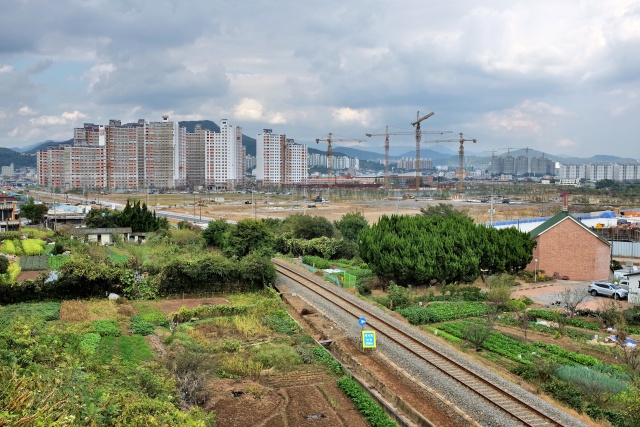
Suncheong: The city is rapidly expanding
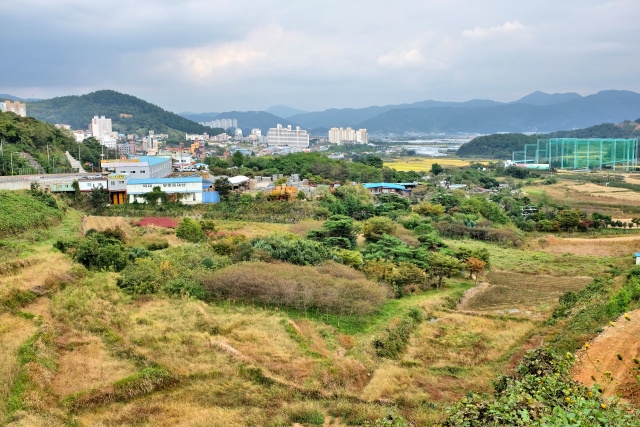
Suncheong: City outskirts
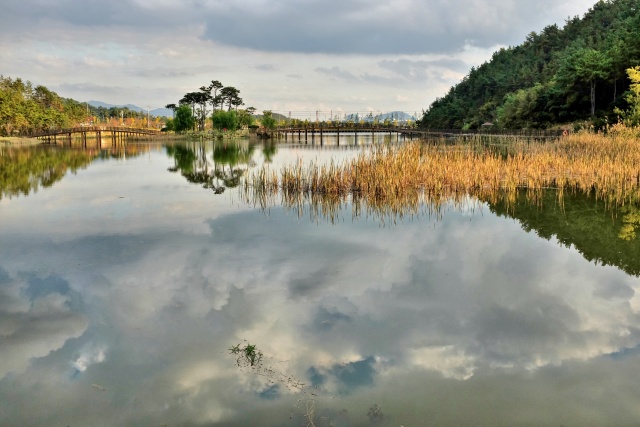
Gwangyang: Lake where I spent the night
There was mist again the following morning. I packed up my tent which was dripping wet. The sleeping bag and groundsheet were also slightly damp. I would have to start closing the ventilation hole of the tent. I would need to dry the tent out somewhere during the day, or I would not be able to sleep in it.

Gwangyang: A new bridge under construction
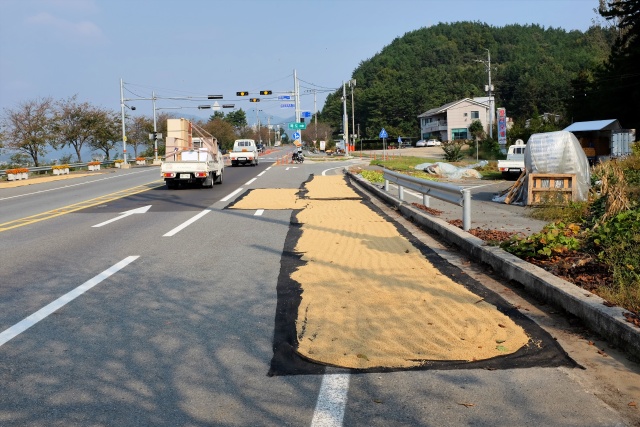
Near Hadong: Rice being dried on the exit lane of a class 1 road
Road 2 was extremely busy. I bypassed it on Road 49 to Hadong. I accidentally entered enormous metalworks and nearly punched my shift in, but the guards, although politely, kicked me out. In Hadong, I went through an intersection on a red traffic light – like a real Korean cyclist and motorcyclist. Over the crossroads there was a 6-meter long black limousine parked. The rear darkened window opened and a well-dressed elderly executive looked out and excitedly greeted me. I had the feeling that he was envious of my sweaty outfit. Everyone has his dreams, some people fulfill them, others don't.
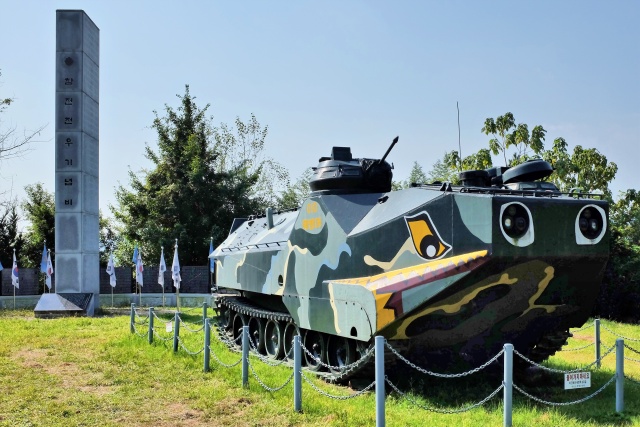
Hadong: Military memorial with a L.V.T transporter
The hills started again in Hadong. Road 2 became a narrow local road. I did not expect any tunnels, everything had to be pedaled up vigorously. The hills were not so steep and it was nice cycling up them. On top of a hill, the wind was blowing, so I pitched my tent to dry it out. That was when Jehu, my cyclist friend whom I had encountered twice on Jeju Island (this is why I remembered his name), suddenly turned up on the hill too. He had worked in Australia for one year and had a good command of English, so we had a great chat. He only carried a big rucksack and usually slept in saunas, for 140 CZK ($7) – for the spa and a communal dormitory on a tatami (mat). This had its limitations – one could not carry much luggage, as only one cupboard was provided.
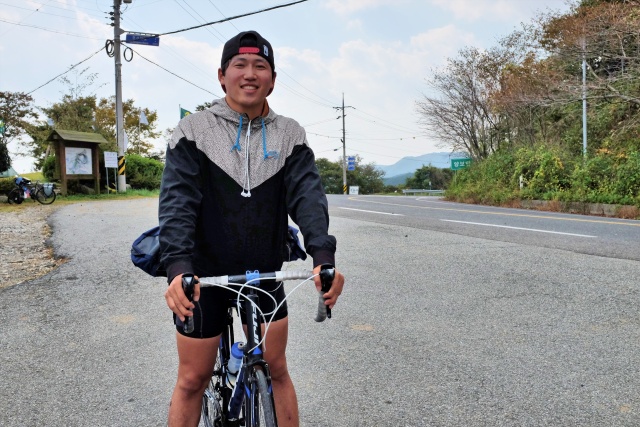
Near Hadong: My cyclist friend, Jehu, whom I'd met down south on Jeju-do, pedaling uphill
Then he was replaced by a married couple, to whom I chatted for about half an hour, even though we only knew about eight words which we all understood. Even with this word deprivation, I managed to crack two jokes. The first one was when I named all my family members. I stressed – showing with my fingers – that I only had one wife. This always seemed to work. Then the lady showed me photos of their daughter, boasting of her beauty. By gestures, I implied that she was beautiful like her mother. She liked that of course, was as proud as a peahen and her husband and I joked about it.
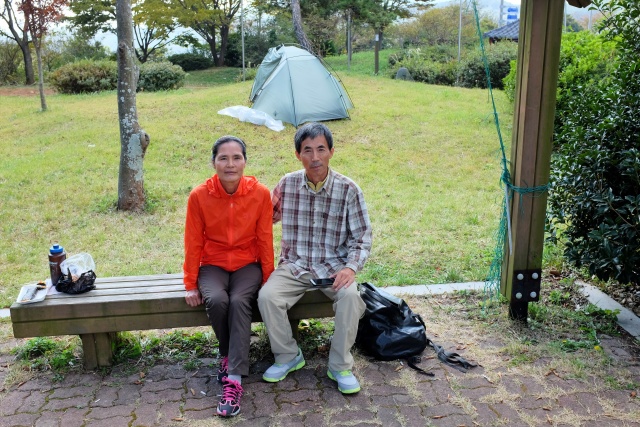
Near Hadong: I had a pleasant half-hour chat with this couple, without actually understanding a single word
Jinjuseong Fortress
Jinju city is a regional center and the main historical site is the lovely Jinjuseong Fortress located above the Namgang River. Of course, I could not skip it. I arrived at 15:00 already and strolled around the Fortress until 18:00, before retreating to the nearest motel.
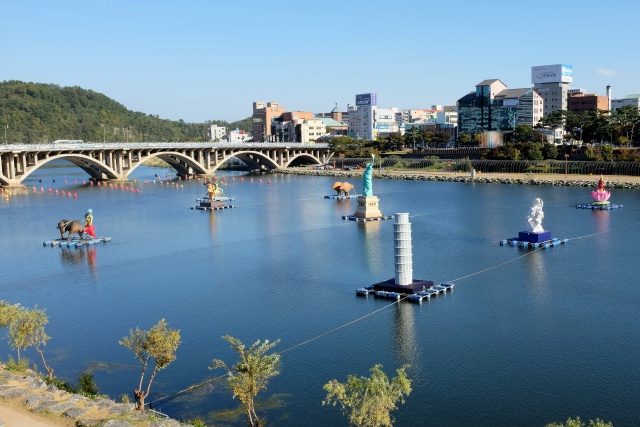
Jinju: Sculptures on Nam River
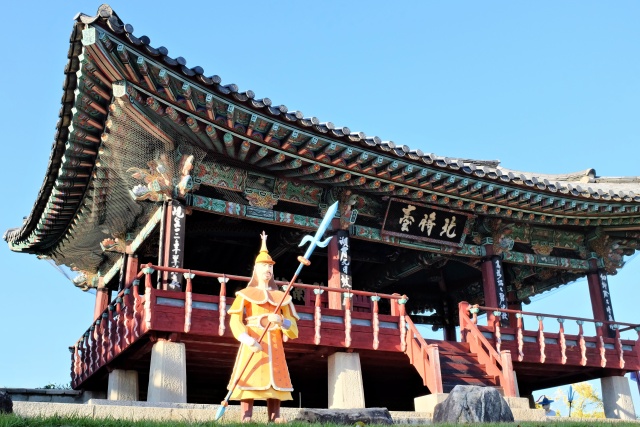
Jinju: Jinjuseong Fortress – guard pavilion
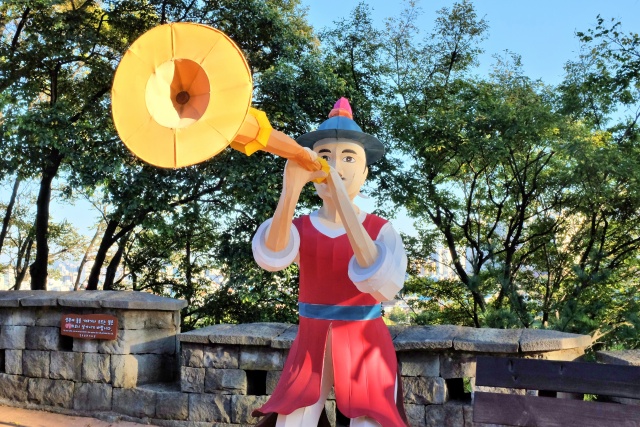
Jinju: Jinjuseong Fortress – one of hundreds of mannequins – wire skeletons covered with thin plastic
The Fortress contained several figures made of wire, thin cloth and plastic. Even the greenery all around — the trees and shrubs — were decorated in this fashion. It had a style of its own and did not look kitschy. On the other side, on the Nam River, there were kitschy statues everywhere – the Statue of Liberty, Tower of Pisa, matryoshkas, dalmatians, the Sphinx, and heaven knows what else.
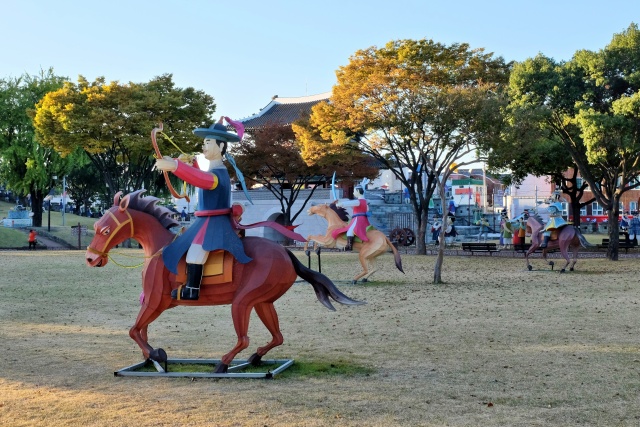
Jinju: Jinjuseong Fortress – horsemen
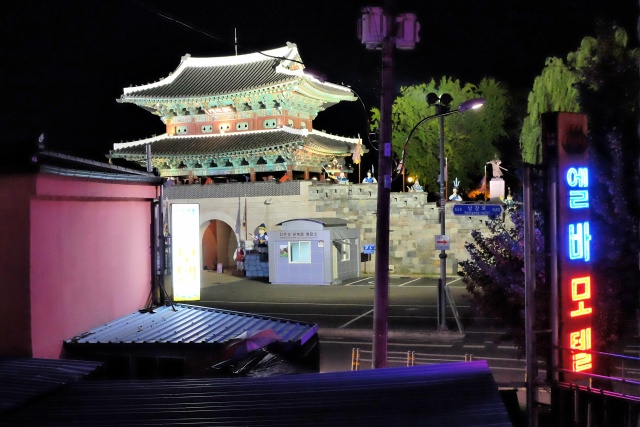
Jinju: Jinjuseong Fortress – view from my motel room window
On the cliff under the Fortress was a memorial dedicated to the Korean girl, Nongae, for her heroic death. After the Japanese took over Jinju during the 16th century, she was chosen to entertain the Japanese bigwigs. She attracted Japanese General Keyamuru to the cliff, jumped into the river and pulled this hated Japanese with her.
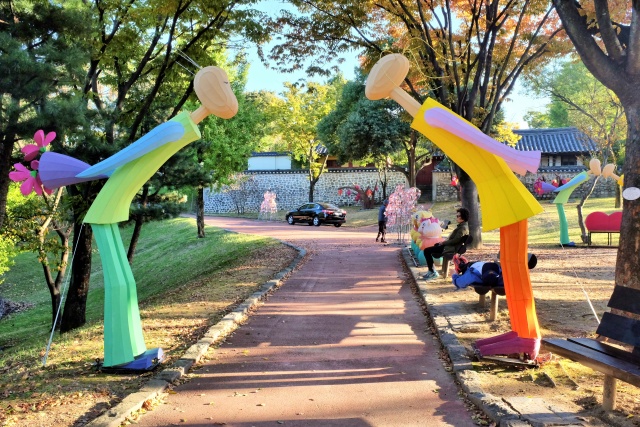
Jinju: Jinjuseong Fortress – Love Street
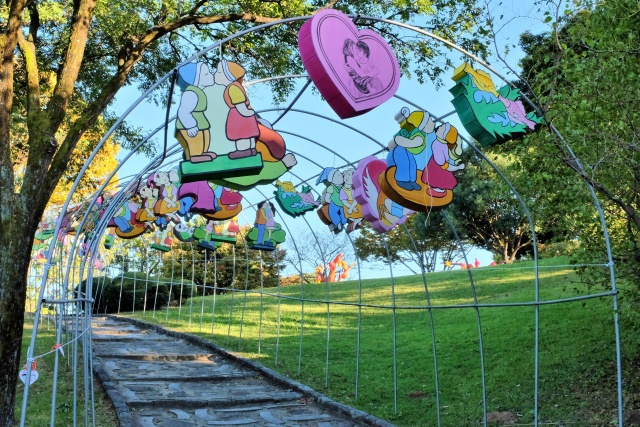
Jinju: Jinjuseong Fortress – Love Street – bower with instructive pictures
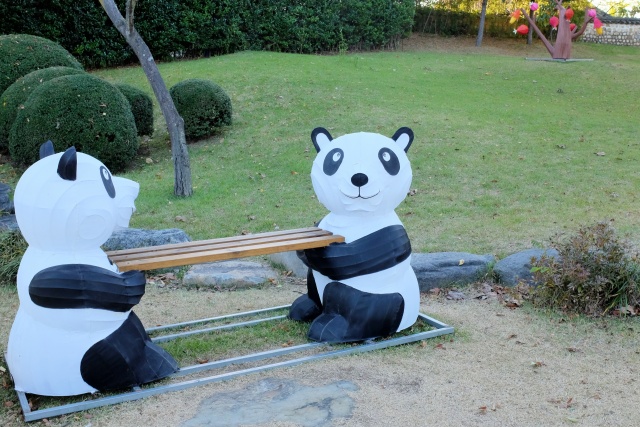
Jinju: Jinjuseong Fortress – Love Street – bench for couples in love – intentionally with no lighting above it
After some days, I finally gained access to the Internet again. I caught up on my backlog, answered mail, checked some news from my homeland, and suddenly it was 01:00. The next day I would have to sleep in a tent in order to catch up on my sleep deficit. Jinju was not small enough to make passing through it a pleasant experience. I was stuck in it for about an hour, suffering the intrusive honking of cab drivers, yielding to buses which did not give me a millimeter of extra space. I located Road 2; a motorway ran almost parallel to it, which attracted most of the cars. Then it was a pleasant ride on a well constructed road with a wide side lane.
Sensor Problems
After about 30 km, I noticed that the cyclocomputer was losing the connection with the speed sensor. In other words, it was not measuring the traveled distance. The speed sensor was new, I had changed it at the beginning of the trip. The wireless connection of the cyclocomputer with the sensor worked only for a very short distance. I figured that the battery must be weak in the cyclocomputer. First I removed all the panniers to access the sensor freely, downloaded the covered distance into the computer and, only after that, started experimenting. A new battery did not help. I exchanged the speed sensor for the previous one, which I forced in (it was not removable) and changed the battery. The same problem. Finally, I moved the sensor from the back to the front wheel, so it would be closer to the cyclocomputer. At first it seemed better, but then the same thing happened. I immersed myself in this problem for over an hour, with no results. I turned on the GPS, so I could at least measure the distance traveled and continued on my way. Some kilometers later I stopped, shook the sensor hard and ever since everything started working again. Nevertheless, I suspected the fault was in the cyclocomputer, it had lived through a lot and I would have to change it (I had used it since 2007). I doubted whether I would be able to purchase one in Korea or Japan.
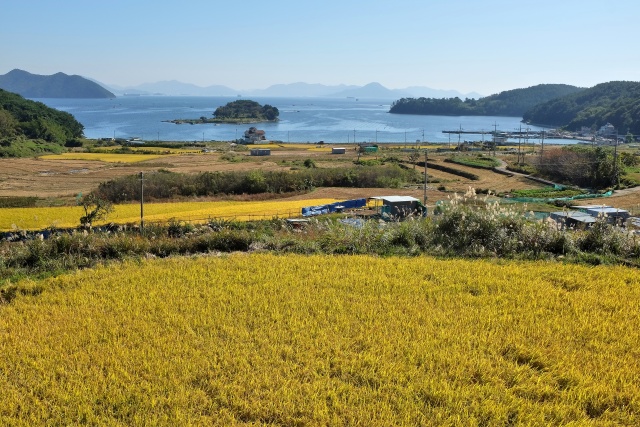
Near Masan: Rice field stretching down to the ocean
The idyllic cycling ended when Road 2 declared itself to be a motorway and I had to exit. The countryside was very hilly, Road 2 entered long tunnels. I bypassed it on a country road, up and down, over 10 % ascent. I warmed myself up thoroughly, which was necessary. Beautiful fall weather, the air as transparent as polished glass, warm in the sun, but already quite cold in the shade – about 7 degrees Celsius. The downhills were quite cold. I was still cycling in shorts and without a jacket. The next day I would have to put on my warmers.
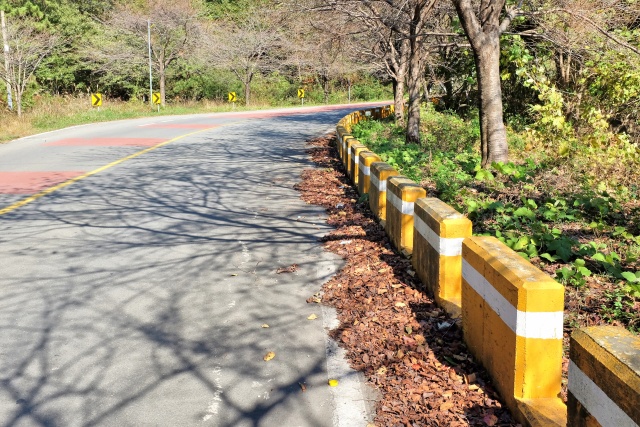
Near Masan: Fall was already approaching
I arrived in Masan, a large city spread around a bay. I was so hungry that I could not have cared less either about the bay or the city. I stopped at the Lotte shopping mall, where 3-D models of meals were displayed, so there was a chance of ordering something one actually had a taste for. I had a taste for everything, but I chose well. The food was not spicy and I ate well. With a full belly, I battled through the busy city traffic, ignored the GPS and followed the signs. I exited the city, located my favorite ablution block in a small park next to Road 2 and had a wash. I pitched the tent and realized that the noise of passing cars would not allow me much sleep. I left everything there, walked around the vicinity and found a pavilion 300 meters away on a hill. I folded up the tent again and moved to this quieter spot.
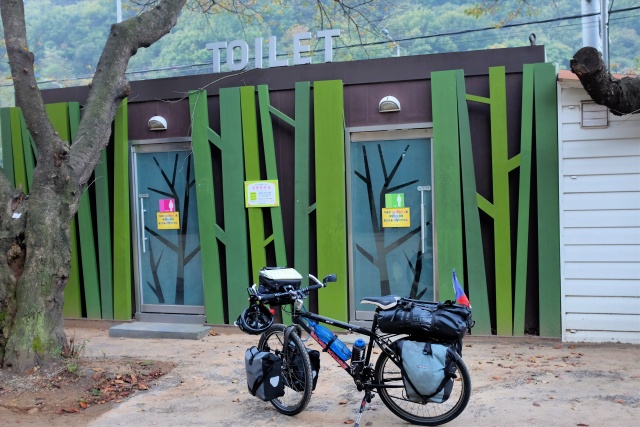
Masan: My point of reference
Busan for the Second Time
I woke up really well rested at cockcrow, which took place at 06:00 At 20:00 the previous night, I had tucked myself into the sleeping bag in order to warm myself up, with the plan of reading until a bit later. But when I woke up again, it was already morning. I skipped breakfast, had a wash and got going. Luckily it was a steep uphill, so I warmed myself up a bit in that 6-degree temperature! I was wearing the jacket and leg warmers already for the second time and considered taking out my gloves. I arrived in Jinhae and, in the first convenience store already, bought and ate my favorite Sesame ramen, made a cup of tea and ate my breakfast in front of the store. The advantage of these local spicy soups is that they warm one up in cold weather, while at the same time supplying the body with the necessary fluids. Then, over hill and dale, I arrived on the outskirts of Busan. Following the GPS, I reached the end of the bike path (the same one I had been on over a month before) and repeated the Metro trip, exiting in Centum City, ate in the Lotte shopping mall and cycled again to the familiar Gwangalli Beach
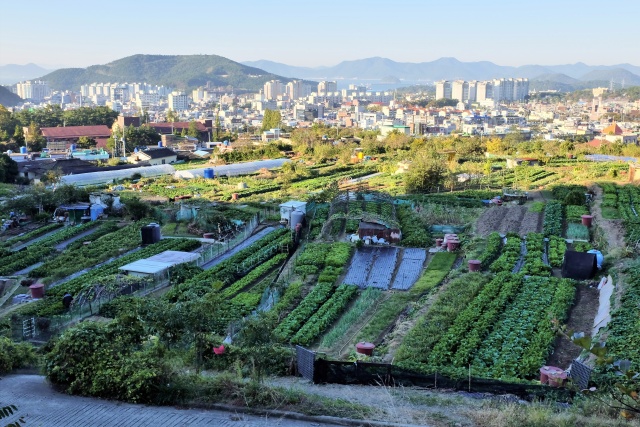
Jinhae: Suburbs
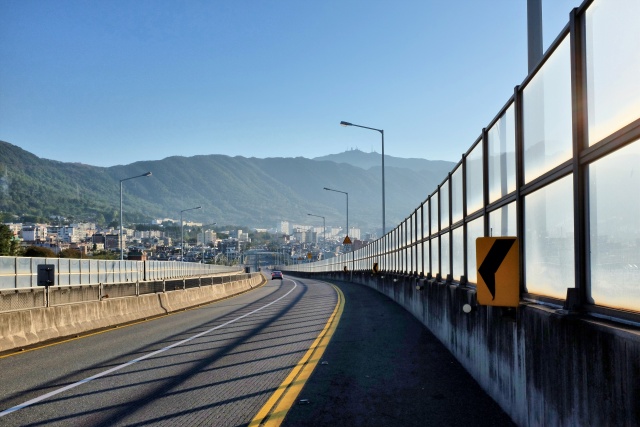
Jinhae: Road with sound barriers
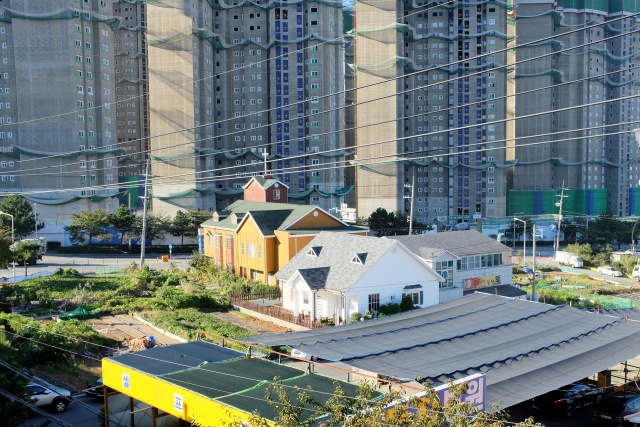
Jinhae: A little church lost between massive apartment blocks
I wanted to stay in the motel which I had not stayed in the previous time, because I knew it had reasonable rates. Oops! The cheap rate applied only to work days, on Saturdays it cost three times as much and on Sunday twice as much. It was a Saturday, really expensive: 2000 CZK ($100). I found this a bit exorbitant. I went to some other motels; they were a bit cheaper (1600 CZK for a Saturday night, $80) but I did not find that reasonable. About 500 meters from the beach I found a motel where they wanted the usual 1000 CZK ($50) for the night. The room seemed fine, with the standard equipment, TV, fridge, kettle and a computer. So I only removed the network cable and plugged it into my laptop. They allowed my bicycle inside, great.
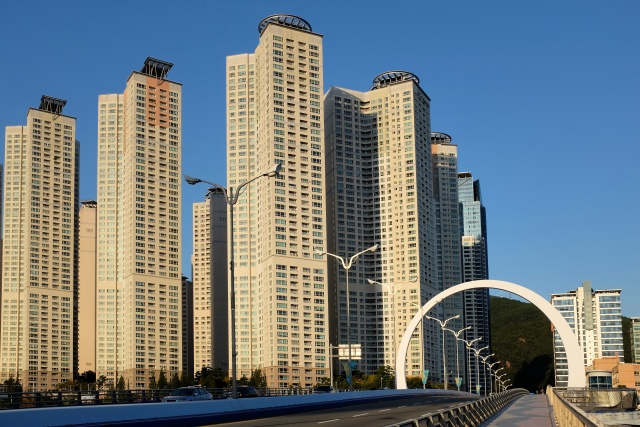
Busan: There are many people, land is expensive and so buildings reach for the sky
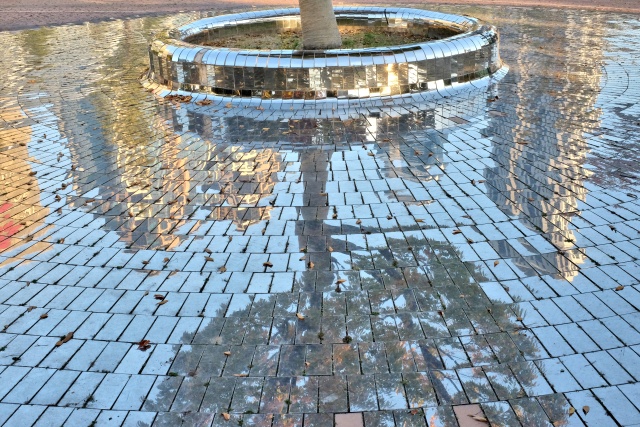
Busan: Reflections in the glass paving
It was interesting to see how women are much tougher in business than men. I needed to wash my clothes, so I acted the usual pantomime on this subject. The lady indicated that she had no washer and that I needed to wash by hand. However, I could dry the clothes on the roof and her husband would show me the way. The roof was perfect – clothesline, pegs. Her husband winked at me and opened a small room with a washer. I ran down for the clothes and he fixed everything, washing and even hanging it all up exemplarily. I only needed to collect it after I returned from the city.
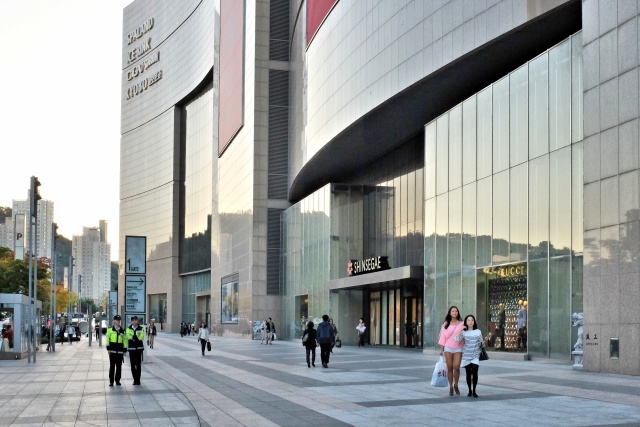
Busan: Shinsegae – reputedly the biggest shopping mall in the world
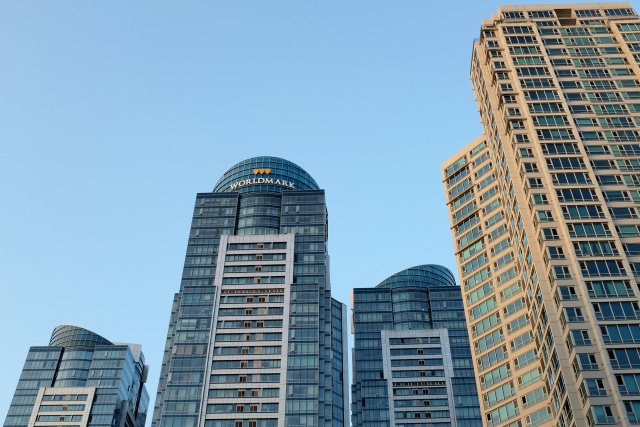
Busan: High buildings surround Centum City
In the evening, I received an e-mail from an unnamed cyclist friend, whom I had encountered several times on Jeju Island. He was a nice guy, could speak a little English and was interpreting for the whole cycling community, who had a bunch of questions for me. I sent my blog: kolemkolem.cz to all their smartphones, posted the image of my altitude graph in Bolivia and was regarded as King. When I answered their question about my age, they rolled their eyes.
Decent people are used to attending church every Sunday. I headed for the Beomeosa Temple. I took the Metro to the station of the same name and then walked mainly on a footpath another 3 km through a dense, beautiful forest. Although a frequent bus service was available from the Metro station, I had to get some exercise, as I would not be cycling that day. The Temple itself was not so attractive, it did not help that construction and repairs were going on. However, the vicinity was magical, thick forest, steep hills and a creek edging its way around big rocks. That is why it is also the starting point for tourist trails, specially to the 3 km distant Geumjeongsanseong Fortress. At first, I also wanted to walk there, but the unreal hordes of tourists demotivated me. And that was only at 10:00.

Busan: Closed metro platform doors open only after the train arrives
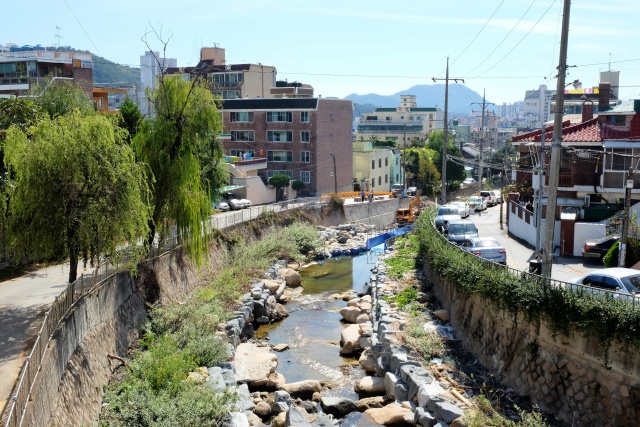
Busan: Close to Beomeosa metro station
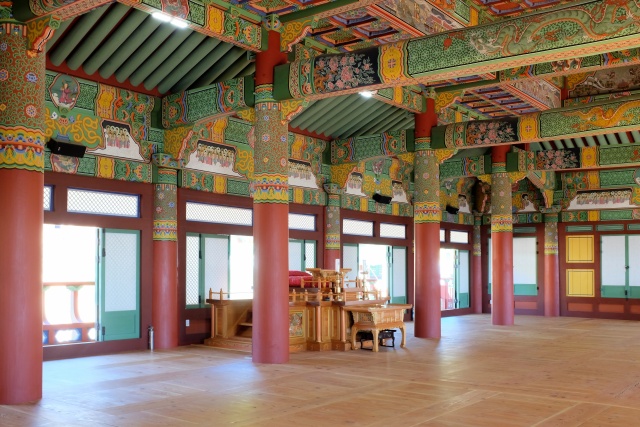
Busan: Pavilion above the entrance gate to Beomeosa Temple
Beomeosa Temple is popular among international tourists, as it also runs a "homestay," which is a one-night stay in the Temple. For 24 hours, the tourist lives with the monks, eats their simple meals, sleeps in a similar bed, performs easy work and takes part in meditation sessions.
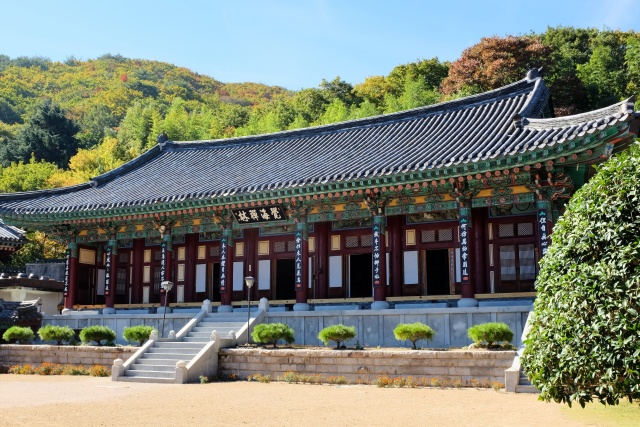
Busan: One of the Beomeosa Temple buildings dedicated to the ”Homestay” program
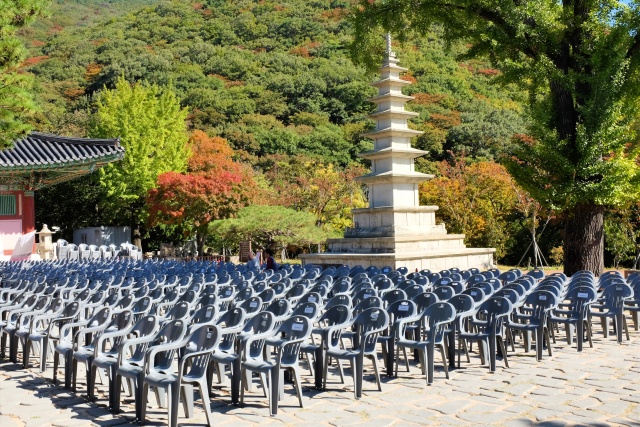
Busan: Preparation for a big Sunday event in Beomeosa Temple
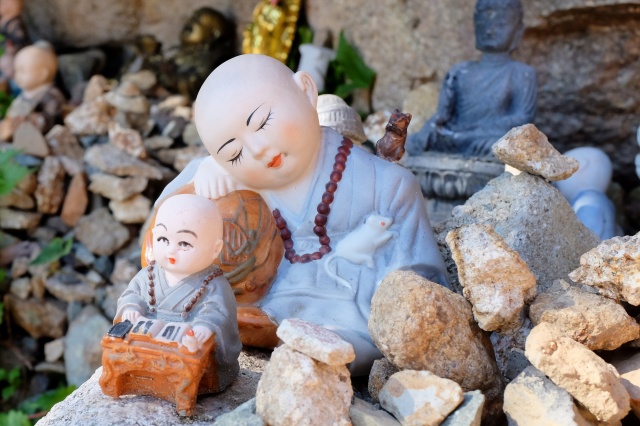
Busan: Beomeosa Temple – little friends
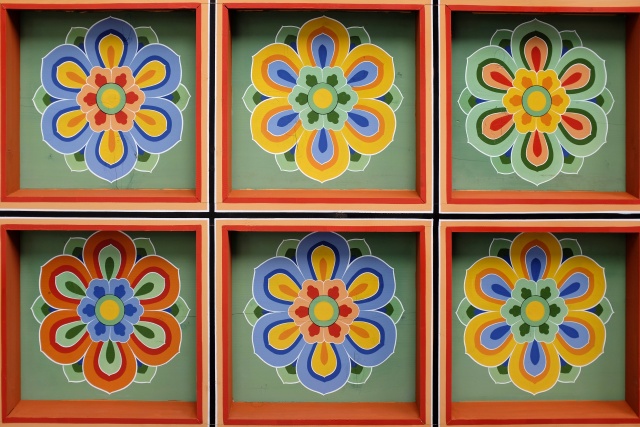
Busan: Ceiling of one of the gates of Beomeosa Temple
I strolled around the Temple and photographed two girls resting on a big stone, without them noticing. On my way back, they started talking to me. One of them had worked on a promotional event for Czech Airlines on the previous day. As you surely know, this airline was purchased by the Koreans. I took her e-mail address and in the evening sent her the photo I had taken.
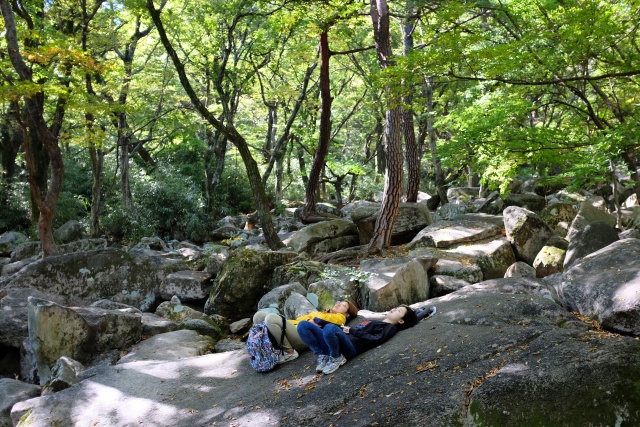
Busan: Girls relaxing in the vicinity of Beomeosa Temple
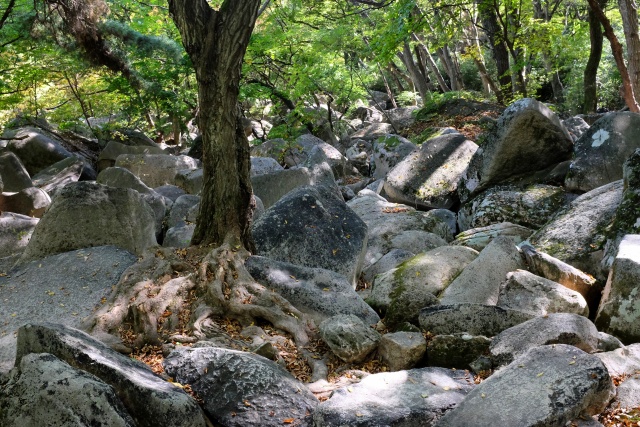
Busan: Beomeosa Temple surroundings

Busan: An unbelievable horde of tourists at the starting point of the hiking trail at Beomeosa Temple
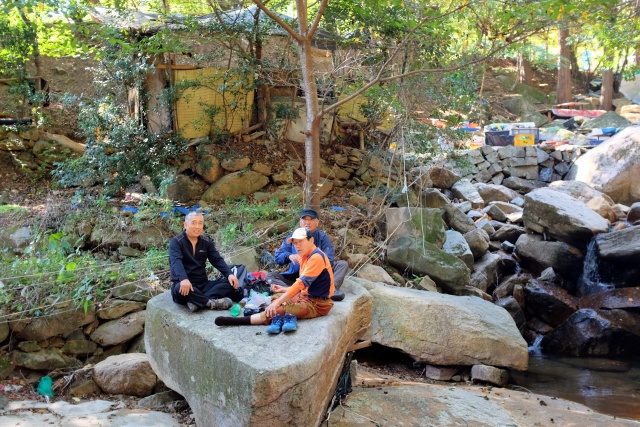
Busan: Picnic near Beomeosa Temple hiking trail
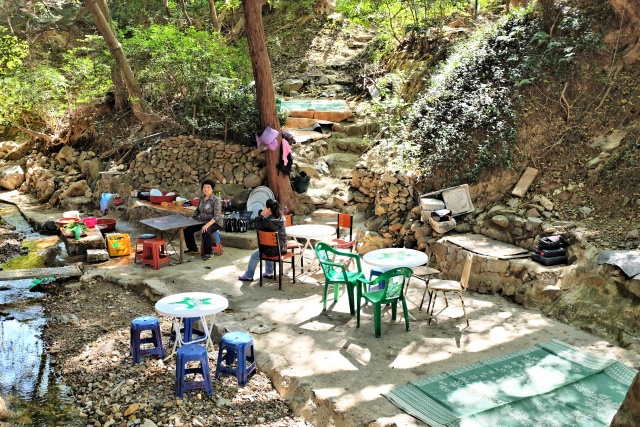
Busan: Waiting for customers at Beomeosa Temple hiking trail
I returned to the city, walked around Busan Station where there was a small Chinatown, but where Russian signs dominated. I used the remnants of my Russian and, when invited to enter a Russian pub, answered "spasibo" which led to a lengthy conversation. Something like Massa Bob Russian from my side, but we understood each other.
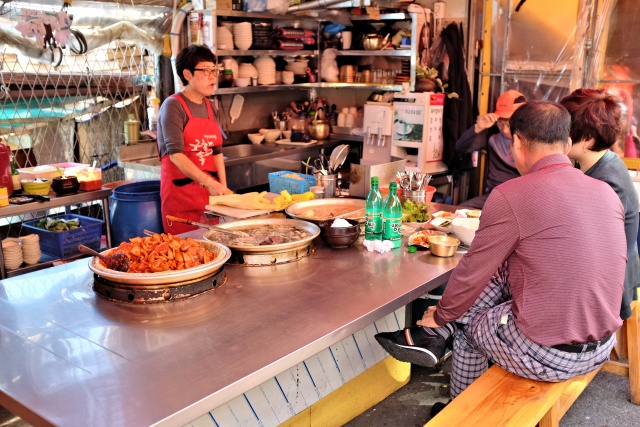
Busan: Numerous small restaurants at Jagalchi fish market
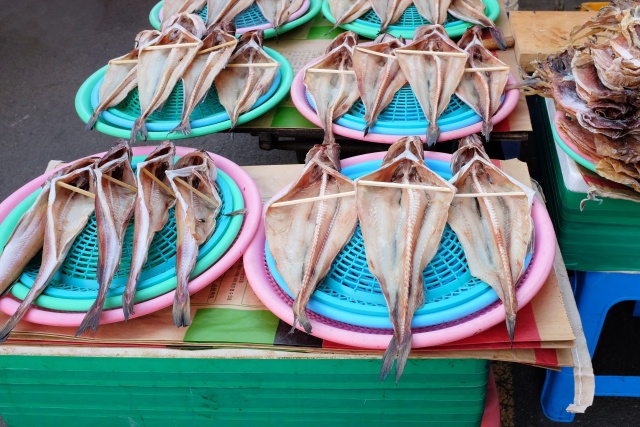
Busan: Jagalchi fish market – dried fish
I took the Metro for a short distance to the famous Jagalchi Fish Market and ate my next meal in one of the myriad of restaurants. I only avoided the raw fish. The market was packed with people, puddles everywhere from the water overflowing from tubs, all accompanied by a specific sea aroma, or stench, depending on one's personal taste.
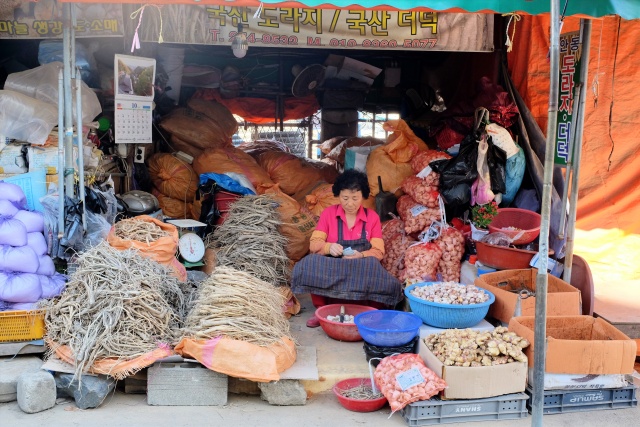
Busan: So, how much did you make today?
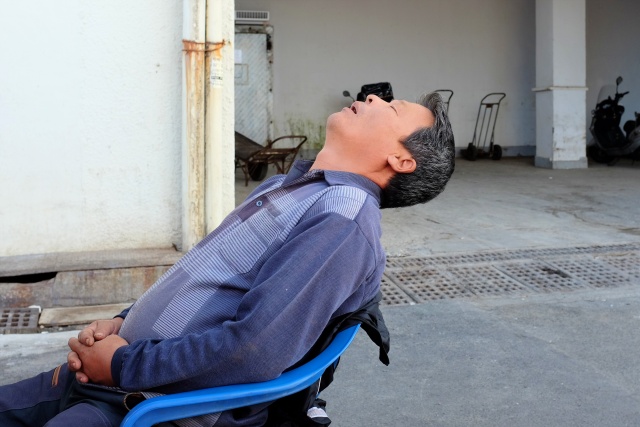
Busan: Business is slow, I have to think about it
All the fish sold on Jagalchi Fish Market were presented as fresh. In many cases it was true, especially in the cases when you could see the fish still swimming in the tubs and big aquariums. However, at the far end of the market I saw frozen fish being taken out of polyester boxes, and water being poured over them to transform them into a "fresh" state. Surely only a minimum number of fish is sold this way, but it is always a good idea to check the purchased fish properly, in this case, its cloudy eyes.
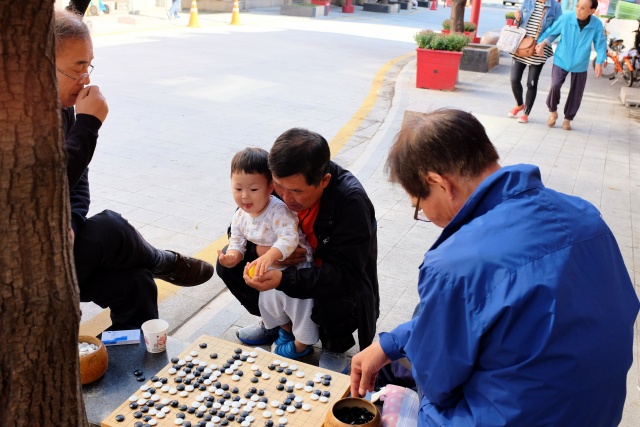
Busan: A little spectator
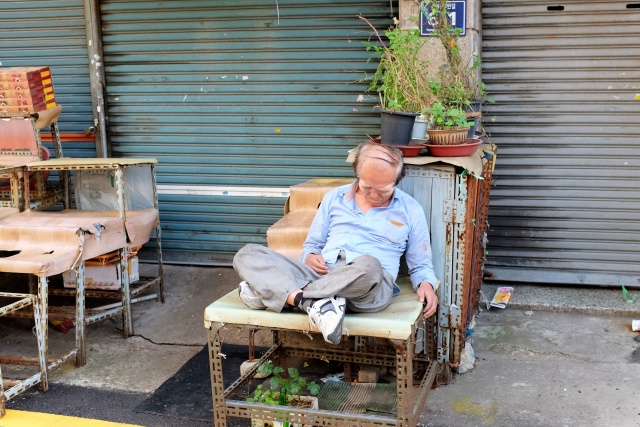
Busan: Relaxing in a side street
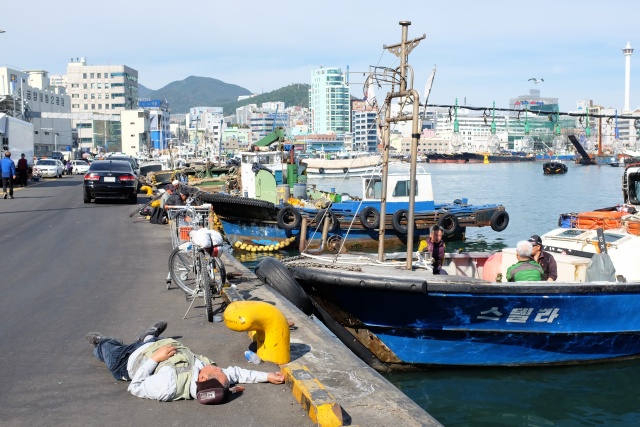
Busan: After a few bottles of soju it is necessary to rest for a while
Next, I took a long walk around Nampo Station and along the shore opposite Yeongdo Island. Then I returned and strolled around after dusk on the beach illuminated by reflections from a bridge on the other side of the bay. This would be the end of my stay in Korea. The next evening I wanted to board the ferry to Fukuoka to continue my trip to Japan.
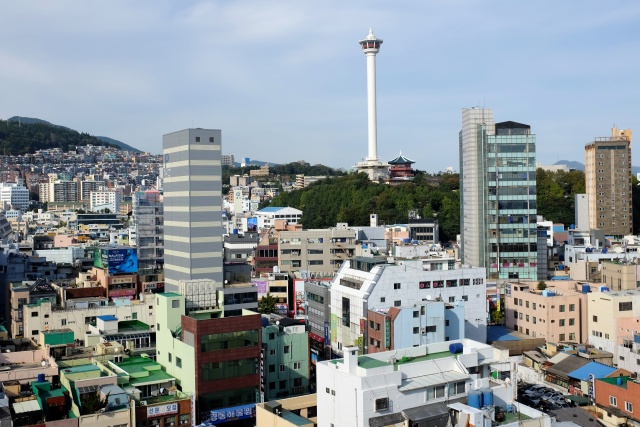
Busan: Busan watch tower
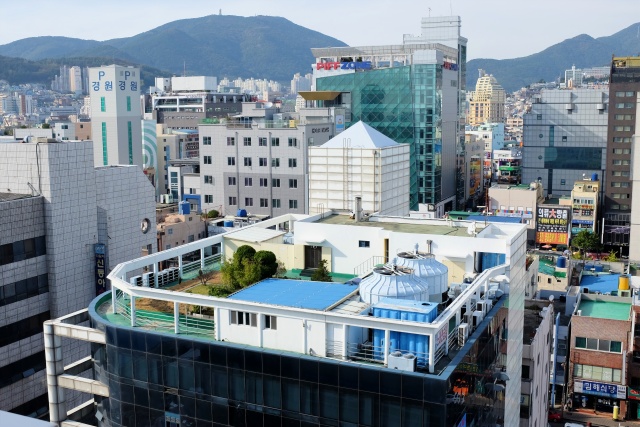
Busan: Surroundings of Nampo metro station
My prediction from the previous evening came true — the weather changed in the morning. It poured with rain. I left the motel at 11:00 and the ferry was due to depart in the evening. There was not much to do in such heavy rain, reminiscent of a storm. Unfortunately it was a Monday, otherwise I could have buried myself in museums and at the same time learnt something new. At least I went to see the cemetery of the United Nation Soldiers who had died in the Korean War. A total of 16 countries had sent their troops to support the present South Korea and another 5 countries had provided medical assistance. I did not stay there for long, the rain was persistent.
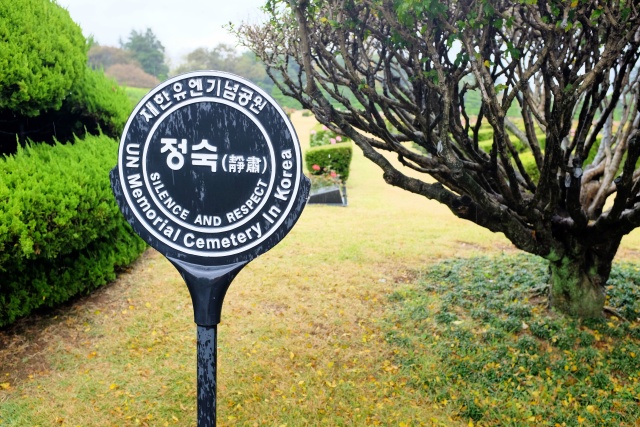
Busan : UN Memorial Cemetery – a copy of Arlington Cemetery
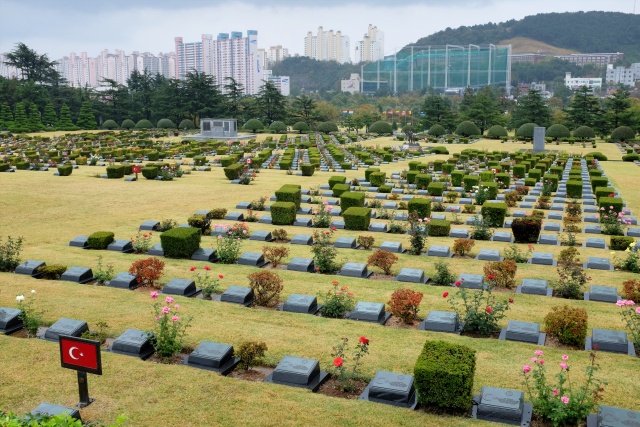
Busan : UN Memorial Cemetery for soldiers fallen in the Korean War
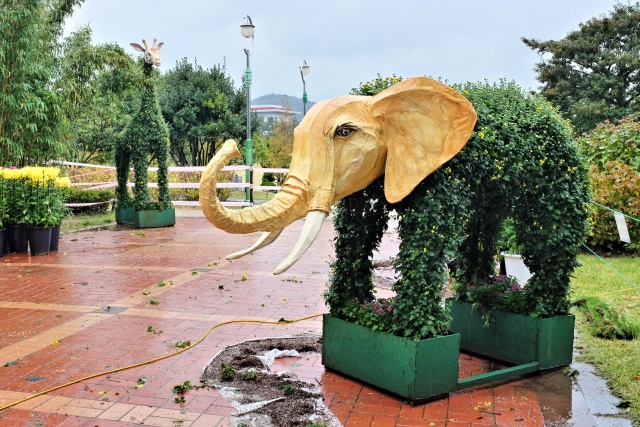
Busan : Animals in the park
I cycled to the harbor, purchased the ferry ticket. I then retreated to a nearby shopping mall for an early dinner. The market was out of the question, as I had no cash left. I purchased some supplies, so I would not be hungry on the voyage, although there would surely be something to eat on board as well. I had to check in my bicycle separately before 18:15 and "foot-soldiers" would be loaded between 19:00 and 19:30. The ferry was scheduled to sail at 22:00 and arrive at Fukuoka at 06:00. I would see how it all worked out.
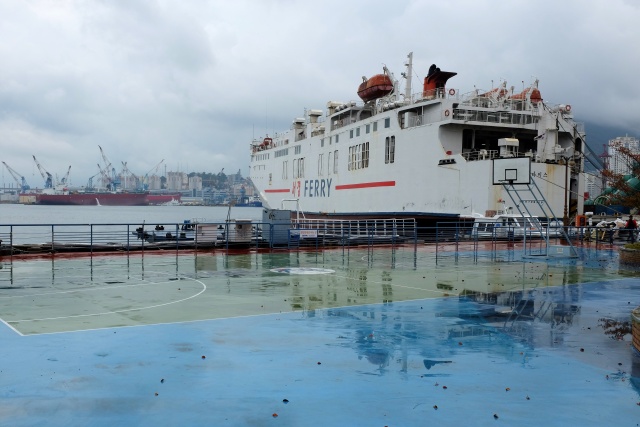
Busan : Small ferry in the harbor
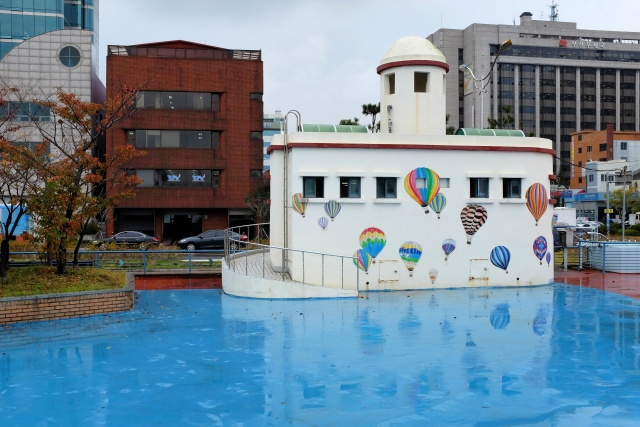
Busan : Stylish public bathrooms in the harbor park
